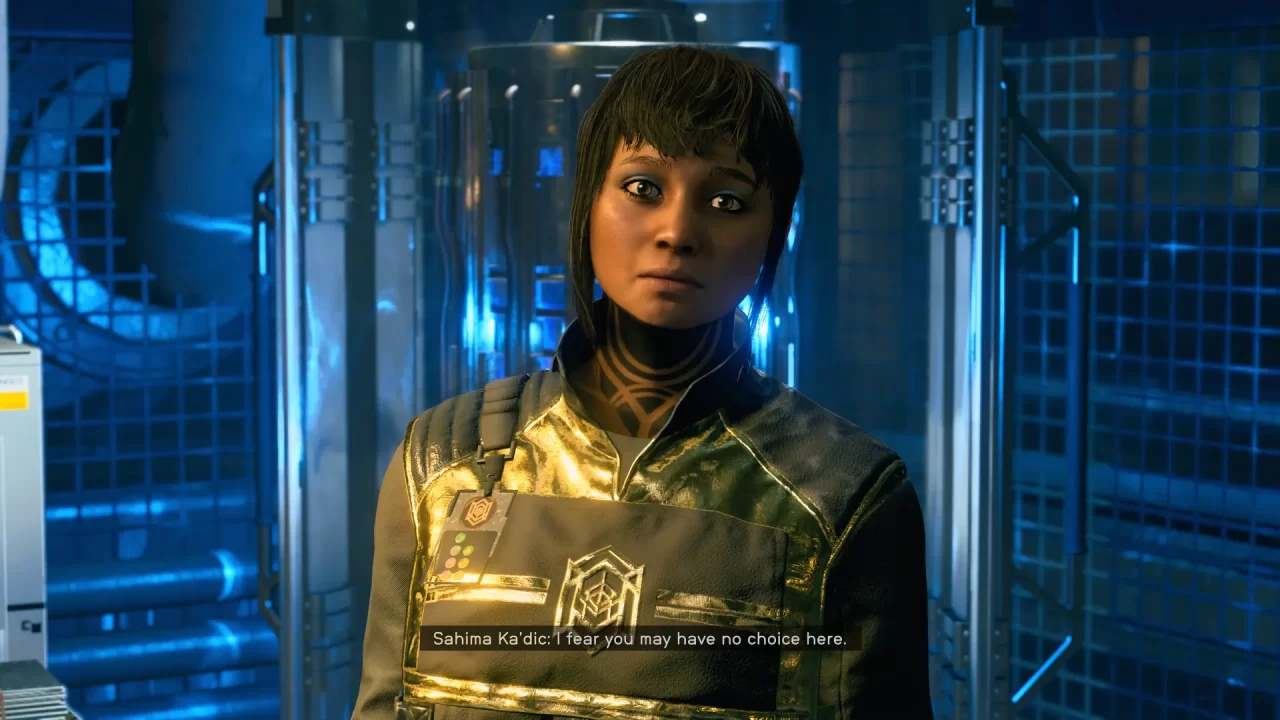Starfield: Shattered Space Review | RPGFan


Starfield’s first major story expansion is here, and it is predictably handsome and shallow. Moreover, Shattered Space is an imperceptive, often tone-deaf, attempt to reorient fan and critical reception after the base game’s botched launch (I even acknowledge this as a person who genuinely cherished the base game).
Shattered Space starts like any Bethesda DLC: you buy the expansion, “randomly” encounter a DLC character, and then gain access to the new in-game content. Typically, this is a new or revamped zone with brand-new quests, NPCs, items, weapons, and so on. In Shattered Space’s case, a space station called The Oracle is the “random” encounter bridging you to new content — its systems have gone haywire, its inhabitants have vanished, and it needs you, the player, to navigate its strange, teleporting goo-filled innards to unravel its ghastly mysteries.
The Oracle is a fun evolution of the DLC introduction trope for Bethesda Game Studios, and it is by far the most competent part of Shattered Space. In it, you navigate hazardous zero-gravity rooms with six-sided “the floor is lava” puzzles and blinking ghost enemies. The Oracle is concise in its design, and it keeps the focus on the action: it has quick puzzles, a legible map centered around a large cylinder, and plenty of cover to maintain the flow of its vertically oriented combat, even as enemies blip across the map. It also has a compelling horror flair: The Oracle’s occupants have been spirited by an experiment gone wrong, turned into disoriented apparitions forced to haunt their familiar research station as they slip across space-time. They jump, mostly uncontrolled, around their still-humming instruments and the floating corpses of their coworkers, creating a phenomenon where both the enemy characters and the player character are confused and on edge, in a shared fugue state of space-time dysphoria. This troubles horror shooter genre conventions in an interesting way.
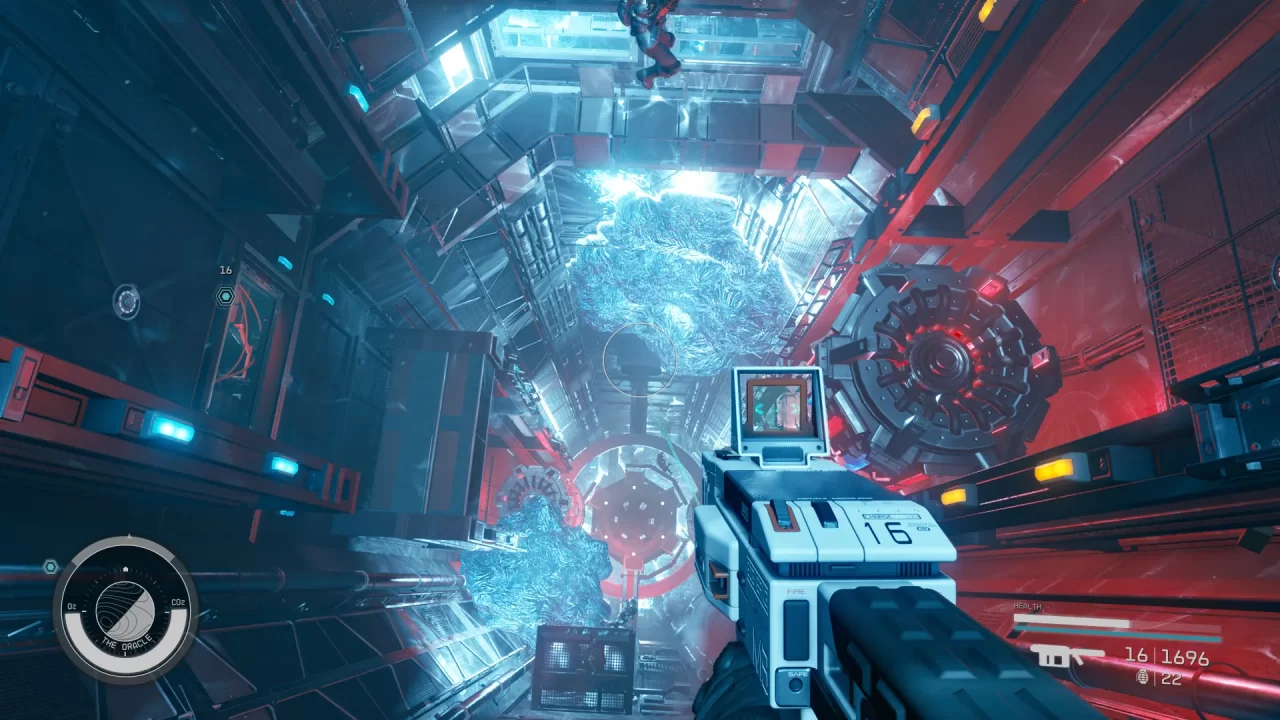
Furthermore, there is considerable attention to detail in the making of the Oracle level, both in its design and story; it is well-tuned for exploration, zero-G combat, and strange object-collecting while also adhering to Bethesda Game Studios’ (BGS) familiar environmental storytelling. In this way, The Oracle — perhaps Shattered Space in general — still feels familiar. It returns to a formula the developer is known for: delivering artisanal world zones with complex NPC pathing, timed events, decorative pickups, and environmental puzzles. As Shattered Space sticks to a single handcrafted (i.e., not procedural) planet zone for the duration of Shattered Space, alongside the Oracle introductory zone, it shows a clear back-to-basics design philosophy, where BGS applies their environmental storytelling chops to large, just not planets large, handmade levels. In short, Bethesda tried to give us a Bethesda game, whether or not that intention was misguided.
Admittedly, on the positive side of this “familiar” design, the game remains nice to look at. With recent updates that open up the game’s framerate and give players new traversal methods, the game moves much more smoothly through its spaces. Furthermore, being arguably much more handmade and not algorithm-made this time, the DLC gives us Starfield’sprettiest location to date: Dazra. Dazra is the home city of House Va’Ruun, filled with Va’Ruun citizens from major and minor families within the faction. Each of these characters is well-modeled, with unique designs sporting believably jagged fashion and facial features. The space snake-worshipping colony is full of unique ephemera, too: strange artifacts, interesting and colorful architecture, pristine monuments, weird tchotchkes, and, of course, a giant crater filled with that anti-grav teleporting hazard goo from the Oracle intro.
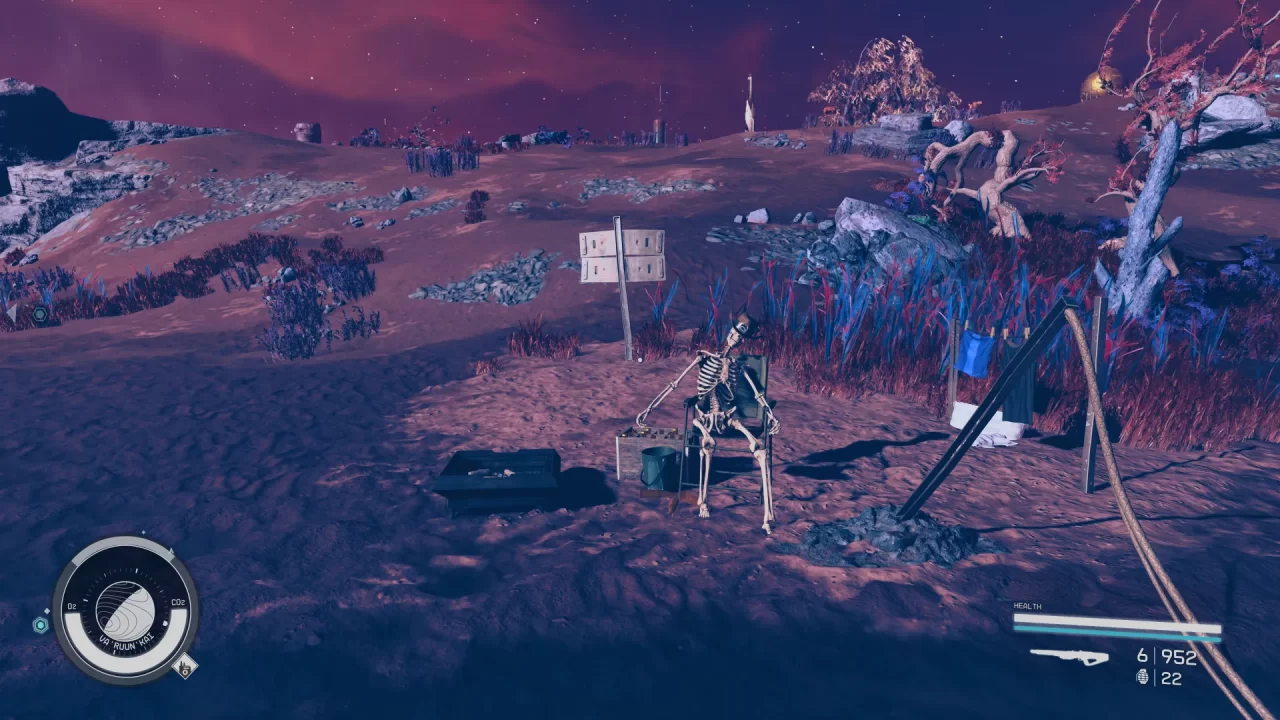

I find it odd, though, that the DLC focuses on its “shattered” locale (see: hazardous crater) when all of it, besides the crater itself, is pristine. There’s a dissonance here, not just between how half of Dazra is unblemished and half of it is apocalyptic; it is also a strange choice for Bethesda to return to their design ‘basics’ yet make a cataclysmic zone its focal point. To be fair, Bethesda is exceptional at making destroyed spaces (see: the Fallout series), just not recently destroyed spaces. To illustrate this, consider The Elder Scrolls V: Skyrim’s introduction, wherein a dragon ravages the cobblestone and wooden structures of the small starting hovel. Rubble and burning lumber line the environment, alongside a few untouched structures. The abutment of ruinous and fantastical is captivating, but this works because it affects only the starting area — a story-focused setpiece zone that doesn’t need the slower micro-play typical of BGS’ works. This starting moment doesn’t need players to be able to pick up and experiment with every tchotchke in the area, it doesn’t need to allow stealth-archering, and its NPC pathing can all be one-directional (see: running from the fiery dragon). It is merely the thrilling set-up for a more extensive experience of physics-enabled collectible junk, immersive multi-directional NPC pathing, and sneak-archerable zones (see: the Bethesda’ basics’).
As a rule, then, Bethesda games don’t really welcome the path-clairvoyant environmental scrap that you would find lining the walls, doors, and stairwells of a setpiece-focused game like Call of Duty, Portal, or the introduction of Skyrim. Thus, without setpiece scrap to guide the focus of players and level designers, as these items would disrupt both the micro-play and NPC pathing that bring Dazra to life (see: those ‘basics’ again), Bethesda largely fails to make this recently dilapidated zone feel dilapidated at all. Instead of witnessing Dazra’s physically and emotionally present fallout firsthand, players must hear about it from NPCs telling them, “Hey, did you hear there was just a disaster here,” then watch those same NPCs stroll away into their daily routines in an unblemished chrome paradise, seemingly unbothered by its abuttal against the apocalyptic crater they just briefly complained about. It isn’t a fun or interesting exercise to imagine their trauma; it’s jarring and unpleasant. It makes me wonder whether you should design disaster setpieces and tchotchke sneaking into the same game. (See: you don’t, at least not well.)
While Bethesda gets off to a good start with the Oracle section, they fail to hold the rest of the DLC to the same standard of excitement, even with Dazra’s apocalyptic crater. There aren’t many missions in this pack, and most are routine fetch and escort quests. There are no space conflicts, no new companions, and little in the way of content that connects to the base game. Bethesda seems to be performing a back-to-basics move, but in reality, they are out of touch with those ‘basics,’ especially their consequences. The designers at BGS clearly understand that it is interesting and compelling for players to navigate spaces where every object is interactive, where people walk around like they would in real life, and where the passage of time mutates these spaces in believable ways. Because of this acknowledgment, Bethesda has, over the last few decades, crafted living, breathing worlds full of wondrous things, but more importantlyfull of mundane everyday-ness that makes moments like the introduction of Skyrim or the discovery of The Oracle more exciting, because they feel tangible within the context of a living universe. They design quests in these worlds that make use of their heightened lived-in-ness, with all the complexity that goes with that.


But the downside of this design is that it makes for crowded, nonperformant game levels full of janky textures, jarring pop-in, physics nonsense, and irritating crashes — I had three game-closing crashes in my first hour in Dazra alone, probably on account of all the junk they stuffed in there. I noted in my review of the base game that the more open, perhaps less crafted, other-space of Starfield is ripe for exploring your imagination, but it also performed better than any title before it — maybe the lack of bespoke physics-y junk accounted for this fact. Anyway, this is where I think Bethesda misinterprets its own strengths: I believe that crowded, handcrafted environments are what Bethesda thinks they do, i.e., their conception of Bethesda’ basics,’ but what they really do is make space for people to tell their own stories — what they really do is craft mundane worlds not for setpiece contextualization but for honest role-playing, give players Creation Kit tools, and build in-game Creation Kit-lites such as Fallout 4’s settlement builder and Starfield’s outpost mode, all of which enable rich fantasy-making in a compelling elsewhere, whether or not that elsewhere has a robust central narrative.
And Dazra is not a compelling elsewhere, even if it is nice to look at. On the contrary, it is a jarring, buggy reminder of Bethesda’s backsliding self-awareness. Where Starfield felt to me like it finally proved the Creation Engine’s promise of compelling elsewhere-making, Shattered Space feels like a tone-deaf relapse akin to the dissonant and buggy Nuka-World that followed Fallout 4’s wonderfully creative Far Harbor and various Workshop DLCs. Yet again, BGS has ignored fan concerns and is missing the message entirely. For example, space traversal goes entirely unacknowledged here, and as such, late-game space combat remains unapproachably difficult; even with optimal starships, certain space conflicts are impossible without ample ship parts for repair. This means that teleporting between areas is not only faster and simpler, but remains compulsory to avoid impossible late-game space battles. I believe the DLC being single-zone isn’t a concession but a flagrant disregard of this design principle.
Furthermore, the Creation Kit finally came out, many months too late, with little support from Bethesda on the topics of upgraded traversal, planet-making, or new zone instantiation. What’s more, even with mod support and the new rover, moving through open zones is still slow, not only because loading times are worse now than ever, but also because the game’s bloated upgrade system has seen zero buffs, so unlocking faster/easier travel is gated behind unbalanced sluggish leveling systems. Not to mention the little things, like no new content on other planets, Bethesda barely acknowledging the available companions (one of whose stories is entirely centered around their Va’Ruun identity) in the DLC, blatant disregard for the “emptiness” of outer-city zones, and players having little choice in Starfield’s story outcomes.
All of this, however, pales in comparison to the utterly deplorable treatment of modern social issues, including current rhetorics of genocide, in Shattered Space. Early in the Dazra storyline, players meet a nonbinary character named Mirek. Mirek is a spy working for their family to gain information about a group of outcast Va’Ruun’kai natives whose beliefs do not align with those in Dazra. In the process of gathering information, they gain affection and respect for the customs of a people their peers call insurgents, savages, and even terrorists. Mirek is perhaps the sole open-minded character in the entire DLC, asking that we sympathize with the plight of refugees despite the opinions of Va’Ruun elders. Yet they are primarily characterized by an inordinate amount of self-indulgence, eager at all times to hear how smart they are. I like to think most players of this DLC can look past a narcissistic sheen into the open-minded core of Mirek, but there is a particular constituent who love a simplistic binary: narcissism/echoism, he/her, and so on, and Mirek’s character seems ripe for their hateful banter. What’s worse, in Mirek’s mission, “Zealous Overreach,” you must free Va’Ruun hostages taken by these outcasts, using information from Mirek’s spying. Once you finish consulting with Mirek, the game begins to refer to the outcasts as “zealots,” a term notably beloved by supporters of Israel in their ongoing genocide of Palestine. It doesn’t help that Mirek, the only genderqueer character in the DLC and the only one with rational ideas about the outsiders, appears untrustworthy due to their all-consuming desire for praise. Thus, Mirek’s faction sends you on a quest to ignore Mirek’s ideas and wipe out “zealots,” with zero critical choices in the matter.
So, to summarize, Shattered Space brings you to the home planet of a religious extremist faction, pins its most critically thoughtful character as untrustworthy and narcissistic, then asks players to violently disregard them to “eradicate zealots” who have potentially caused the calamity that brought us the infamous apocalyptic crater — except these “zealots” had nothing to do with the calamity; it was funded and executed internally by House Va’Ruun. All of this to “free hostages” whose survival is, notably, optional.
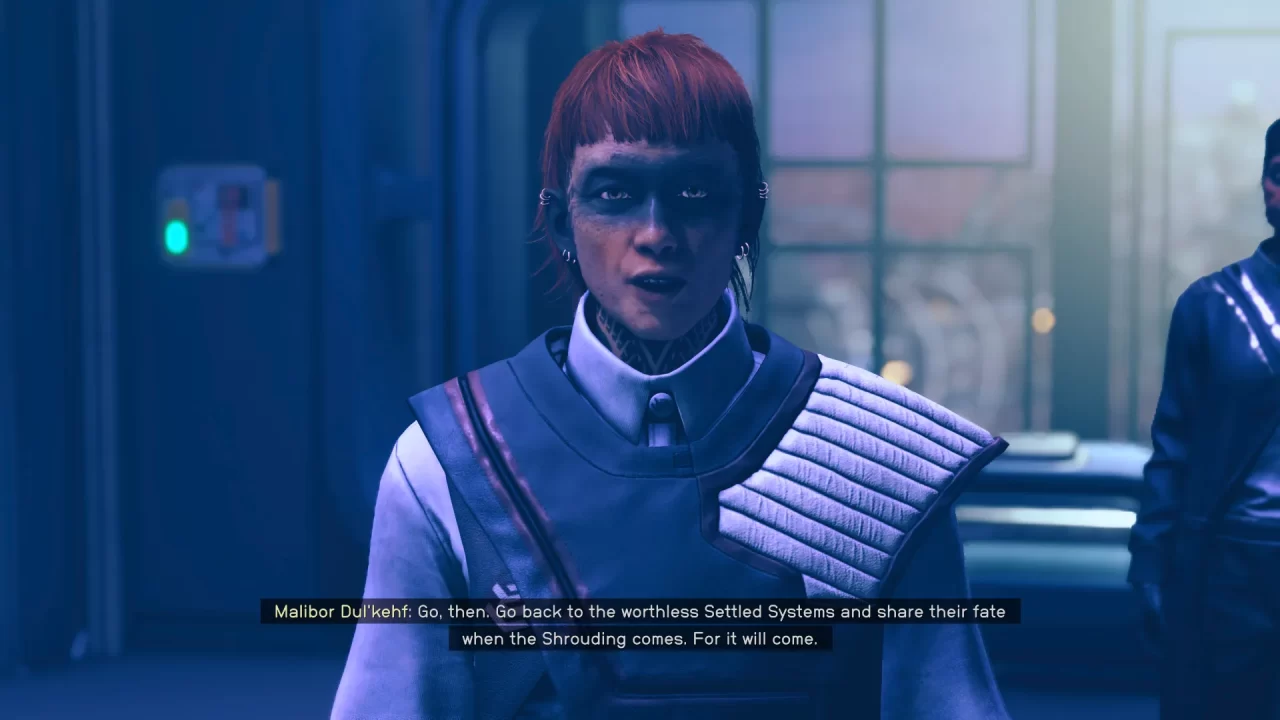

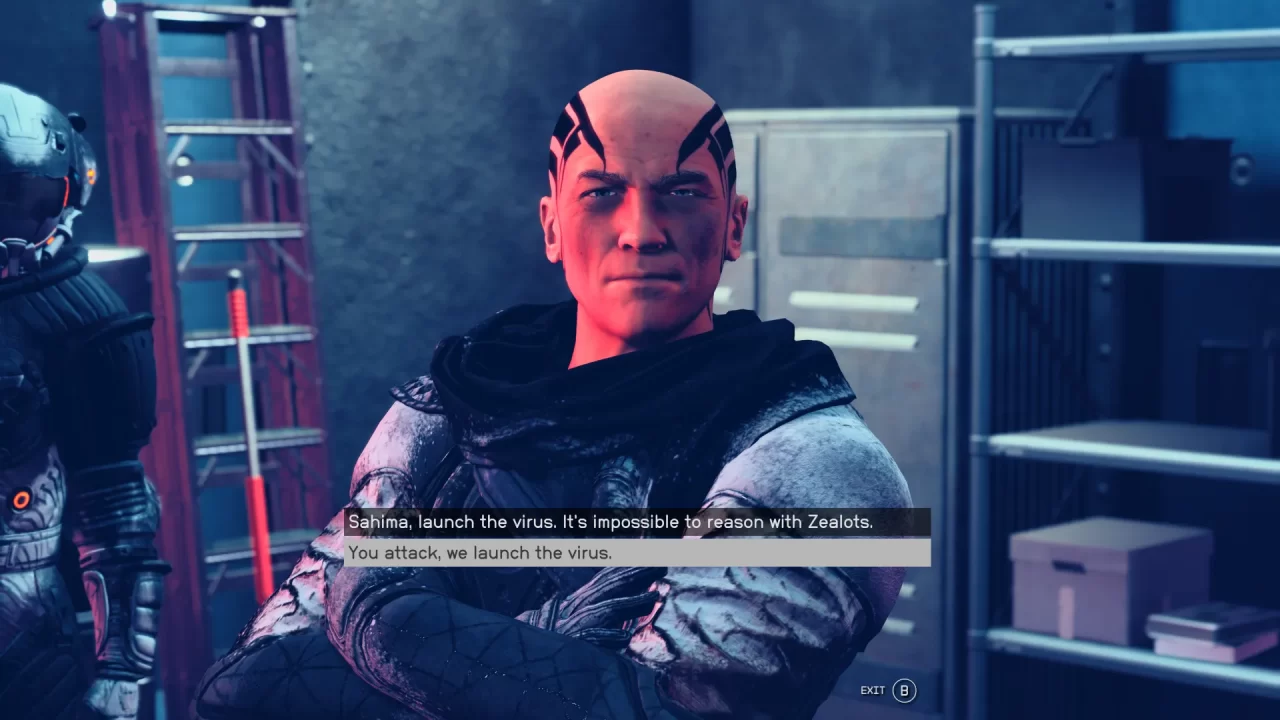



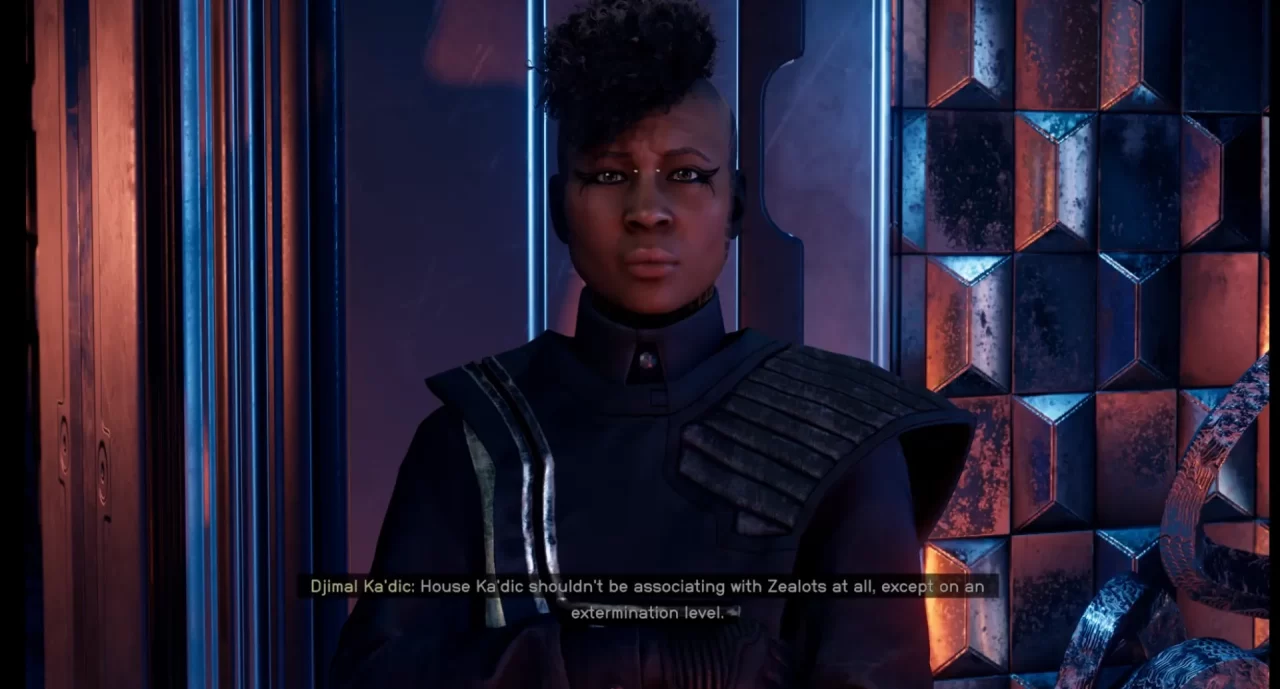

Look, I recognize that science fiction helps us unpack the present moment. I see the value in playing out the shock of a current tragedy and its unpleasant ramifications through sci-fi. However, as a Shattered Space player, you cannot play out anything but genocide in “Zealous Overreach.” You can’t free the hostages without killing “zealots” or ignore this quest to progress; you can’t do anything for the perceived “zealots” but eradicate them. I spent more time trying to get around this than I did on the entire rest of my DLC playtime (~10 hours). My reward for attempting this? Only an uncanny nightmare of hostile bullets and awful dialogue. The game consistently punished me for taking the path of least extermination. And the worst part is that the only choice the player can make to “help” the “zealots” is to kill a particularly hellbent hostage who wants to explode their base for vengeance. However, as GamesRadar+ points out in bold text on their quest guide, “this choice gives you fewer Credits in the end, so it’s not worth it.” Ugh.
What’s worse is that the quest isn’t even critical to Shattered Space’s narrative. It is a frankly pathetic smokescreen to the larger narrative of a messianic figure exploiting and misleading his people for — you guessed it — more genocide. Take “Zealous Overreach” out of the equation, and the DLC, of course, loses its sole queer character, distastefully written or not. Still, it also spares players the pain of compulsory quest trauma, keeping its overarching narrative intact. I just want to know: why do this, Bethesda? For an escort quest? What was the point of that — to make players feel discomfort from being compliant in a horrible situation? Except they’re not discomforted in their compliance, they’re rewarded! Even if players can turn their back against genocide later, they must choose between three other kinds of genocide (present genocide, really present genocide, and probable future genocide) as a reward for that quest. It’s ridiculous.
No, it’s unforgivable. Even putting the awful rhetoric aside, Shattered Space is a tone-deaf, regressive, poorly blueprinted, and poorly executed sorry excuse for a story expansion, favoring looks over substance and regression over progression. It’s no wonder players are dismissing this DLC in droves, because Bethesda disregards them entirely here: Shattered Space tries to adhere to the literacies those fans are familiar with, but it simply doesn’t meet expectations of polish or player choice, and its ambitions are questionable at best — the “message,” if it isn’t strictly Zionist, is inexcusably ignorant. Ya’ll should have kept this one in the drafts, Bethesda Game Studios.
